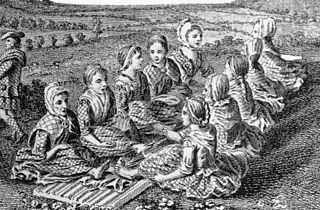 W
WLaundry refers to the washing of clothing and other textiles. Laundry processes are often done in a room reserved for that purpose; in an individual home this is referred to as a laundry room, Laundry in Australian English or utility room. An apartment building or student hall of residence may have a shared laundry facility such as a tvättstuga. A stand-alone business is referred to as a self-service laundry. The material that is being washed, or has been laundered, is also generally referred to as laundry.
 W
WFulling, also known as tucking or walking, is a step in woollen clothmaking which involves the cleansing of cloth to eliminate oils, dirt, and other impurities, and to make it thicker. The practice died out with the modernisation of the industrial revolution.
 W
WA laundry symbol, also called a care symbol, is a pictogram which represents a method of washing, for example drying, dry-cleaning and ironing clothing. Such symbols are written on labels, known as care labels or care tags, attached to clothing to indicate how a particular item should best be cleaned. Standard symbols for these care labels differ by region. In some standards, pictograms coexist with or are complemented by written instructions.
 W
WThis is a list of laundry topics. Laundry is the washing of clothing and linens. Laundry processes are often done in a business, room or area in a home or apartment building, reserved for that purpose; this is referred to as a laundry room. The material that is being washed, or has been laundered, is also generally referred to as laundry.
 W
WLes Lavandières, or the Midnight Washerwomen, are three old laundresses in Celtic mythology. Names in various Celtic languages include the kannerezed noz in Brittany and the Bean nighe in Scottish. They can also be found in the Celtic folklore of Iberia as Las Lavanderas in Cantabria, As lavandeiras in Galicia or Les Llavanderes in Asturias. The three old women go to the water's edge at midnight to wash shrouds for those about to die, according to the myth and folklore of Brittany; or to wash the bloodstained clothing of those who are about to die, according to Celtic mythology. The Midnight Washerwomen may be related to the old Celtic tradition of the triple goddess of death and slaughter.
 W
WSmelly socks are socks that have acquired a strong odour due to prolonged wearing. Their odour, which is complex and remains the object of study, is a mixture of ammonia, fatty acids, and lactic acid.
 W
WA stain is a discoloration that can be clearly distinguished from the surface, material, or medium it is found upon. They are caused by the chemical or physical interaction of two dissimilar materials. Accidental staining may make materials appear used, degraded or permanently unclean. Intentional staining is used in biochemical research and for artistic effect, such as wood staining, rust staining and stained glass.
 W
WWet cleaning refers to methods of professional cleaning that, in contrast to traditional dry cleaning, avoids the use of chemical solvents, the most common of which is tetrachloroethylene. Environmental groups and the United States Environmental Protection Agency have indicated that such alternative "wet cleaning" methods are better for the environment than perc, and proponents of wet cleaning state that these methods can be used without shrinking or otherwise damaging garments that typically require dry cleaning.